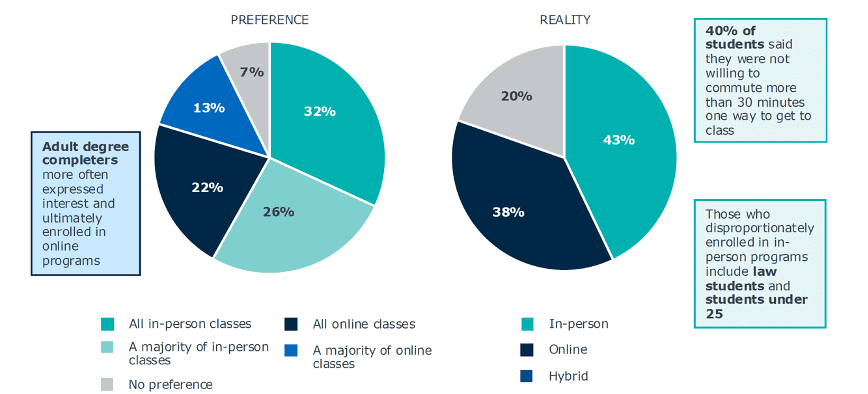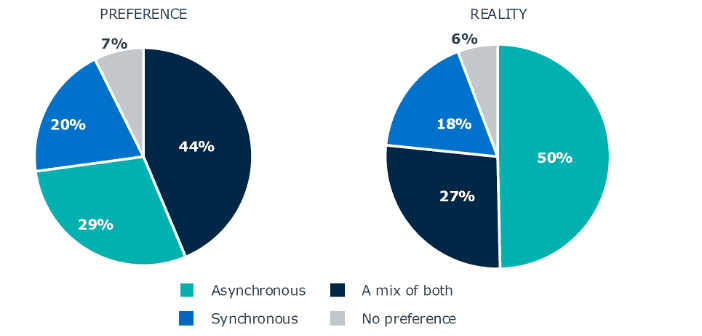Do your graduate and online programs offerings match what students actually want?
The first step in growing graduate, online, and adult learner enrollments is offering programs that actually meet students’ needs and preferences. But that’s easier said than done.
Our recent survey of 6,000 prospective graduate and adult learners shed light on students’ program preferences—including modality, schedule, and course format—and how student preferences can differ from their enrollment realities. Consider these three survey findings when designing and scheduling your graduate and adult-serving programs.
Download the full survey findings
1. Modality preferences are tied closely to student type and program of choice
As always, there is significant diversity in the adult learner population—and in their preferences. For example, adult degree completers more often expressed a preference for online programs than graduate students. Students under 25 and students interested in law school more often said they prefer in-person programs.
Online or in-person? Here’s how business programs are trending
But because adult learners often balance school with work, family, and other commitments, students’ stated preferences often diverge from their actual enrollment decisions. Nearly 60% of students said they prefer mostly in-person courses, but only 43% actually enrolled in an in-person program. For many of these students, an online or hybrid program likely made more sense for their schedules and lifestyles. When designing an online program, consider which components of an in-person experience students value most. How are you ensuring that your online courses are engaging and that students have access to faculty and academic support?

-
Commuting time
40% of surveyed students who plan to or are enrolled in an in-person program said they are not willing to commute more than 30 minutes one way to get to class.
We also asked students about their preferences for synchronous versus asynchronous coursework—perhaps one of the most common questions I receive when discussing online program strategy with partners. Forty-four percent of respondents said they prefer programs with a mix of asynchronous and synchronous elements. But in reality, only 27% enrolled in programs that offer both. Half of the students surveyed enrolled in fully asynchronous programs. This may be, again, due to the need for a more flexible schedule than they had anticipated when initially exploring programs.

2. Half of students want all classes offered during the week
We also asked students about their schedule preferences: which days of the week do prospects want to have class and at what times? Forty-seven percent of students said they want all weekday classes. This was especially true of degree completers, law students, and those who are currently unemployed. Notably, the business students we surveyed disproportionately seek weekend classes; this might be due to the popularity of executive MBA programs which offer weekend classes. And half of respondents indicated they prefer all daytime classes. However, students over the age of 35 and, unsurprisingly, those who work full-time said they prefer evening classes.
3. Students are split when it comes to their interest in alternative credentials
As part of our ongoing research on microcredentials and other alternative program offerings, we asked students to share how likely they are to consider a different credential (badge, certificate, etc.) instead of a master’s degree. Twenty-seven percent of respondents said they are extremely or very likely to consider a different credential in lieu of a master’s degree, whereas 22% said they are not at all likely to pursue a shorter credential instead of a master’s.
To design microcredentials that meet students’ needs, follow these 3 steps
As institutions continue to adapt to the evolving needs of graduate and adult learners, understanding their program preferences and balancing them with practical considerations is crucial. By offering a mix of in-person, online, and hybrid programs, institutions can cater to a wider range of learners and increase enrollment. Providing flexible scheduling options, such as weekend and evening classes, can make higher ed more accessible to working professionals and parents.

More Blogs

What changed in the graduate lead gen landscape in 2025

We secret shopped 40 graduate programs’ lead nurturing campaigns. Here’s what we learned.
